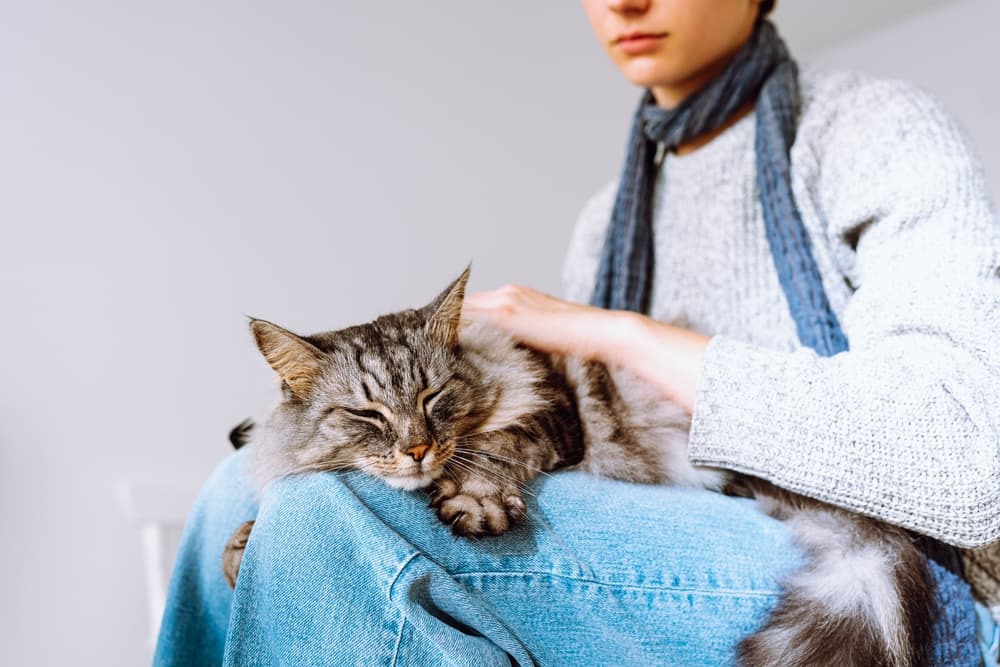Blood in Cat Stool: 11 Common Causes

Pooping is a fact of life for cats. On any given day, your cat’s poop, also known as stool, will look normal: dark brown, firm, and shaped like a log.
But various health problems can lead to your cat pooping blood, which will understandably make you concerned, and perhaps a bit grossed out.
Blood in a cat’s stool is not always an emergency, but it does point to an underlying cause that needs to be diagnosed and treated by your veterinarian.
Blood in Cat Stool: What Does It Look Like?
Looking closely at your cat’s poop is probably not your idea of fun. But being able to describe what the blood in the poop looks like will help your veterinarian determine how the blood got there and how to treat it.
Let’s go through a few things to observe about blood in your cat’s poop.
Color
The color of the blood indicates where the bleeding is occurring in your cat’s gastrointestinal (GI) tract.
Dark and tarry blood – called melena – resembles coffee grounds and indicates a problem in the upper GI tract (stomach and small intestine). Melena’s appearance is due to the blood being partially digested.
Bright red, fresh blood – called hematochezia – is a sign of problems in the lower GI tract (colon, rectum, or anus).
Consistency
Clots of blood in the stool resemble clumps of jelly and point to a problem in the lower GI tract.
Volume
The blood may be mixed throughout the stool, present on one end of the stool, or take up almost the entirety of the stool.
Take note of the stool’s appearance as well. Extremely hard stool is a sign of constipation, while loose, watery poop indicates diarrhea.
11 Common Causes of Blood in Cat Poop

The list of causes of blood in cat poop can run a mile long. Here’s a list of the most common causes:
Constipation: Straining to poop can rupture blood vessels around the anus, causing bleeding. Prolonged constipation can damage the colon.
Diarrhea: Diarrhea can irritate the lining of the GI tract as the loose poop passes through, causing bleeding. Long-term diarrhea can lead to severe dehydration and should be treated promptly.
Parasites: Intestinal worms, such as hookworms, can attach to the intestinal lining, leading to bleeding. Intestinal parasites steal nutrients from their host, causing such problems as malnutrition and poor coat condition.
Inflammation: Inflammatory diseases, such as inflammatory bowel disease, irritate the GI tract lining, causing bleeding. Although not life-threatening, inflammatory diseases are chronic and require consistent management.
Cancer: Cancerous growths in the GI tract can cause bleeding. Cancers range in severity and aggression.
Polyps: Polyps are benign growths but can still damage the GI tract lining and cause bleeding.
Stress: Stress in cats can cause a condition called stress colitis (inflammation of the colon). An inflamed colon can leak blood into the poop.
Infection: Disease-causing bacteria, viruses, and fungi can cause GI upset and bleeding.
Foreign bodies: A sharp-edged foreign body may lacerate the GI tract lining and cause bleeding after ingestion.
Dietary indiscretion: Cats that sift through the garbage may eat something that causes GI illness and bleeding. Dietary indiscretion can be severe if your cat eats toxic food like garlic.
Rat poison ingestion: Rodenticides contain an anticoagulant and are toxic to cats. A cat that eats rat poison or a rat that ate the poison will be unable to clot blood, leading to significant GI bleeding.
Each of these causes requires veterinary attention. Rat poison ingestion is an emergency and must be treated immediately.
Getting a Diagnosis for Blood in a Cat’s Stool
Schedule an appointment with your veterinarian if your cat has blood in its stool. Your veterinarian will first take a history from you and perform a complete physical examination.
Be ready to answer questions from your vet, such as those listed below:
- When did you first notice the blood?
- What does the blood in the poop look like?
- What other symptoms is your cat experiencing (e.g., lethargy, vomiting)?
- Has your cat experienced recent stressors (e.g., new pet, baby, recent move)?
Your veterinarian may also perform various diagnostic tests, listed below, to determine the cause of the blood in your cat’s stool.
- Blood work
- Fecal exam
- X-rays
- Abdominal ultrasound
Your vet may also want to perform an endoscopy of the GI tract, for which your cat would be sedated. An endoscope consists of thin tubing and a camera, along with small pinchers to take tissue samples, if necessary. An endoscopy would allow your vet to see evidence of inflammation, cancerous growths or polyps, and foreign bodies.
How to Treat Blood in Cat Poop

Treating blood in cat stool depends on the underlying cause. For example, a deworming medication kills intestinal worms. Constipation can be treated with stool softeners. Inflammatory bowel disease is typically managed with dietary changes to reduce inflammation and irritation in the GI tract.
Surgery may be the best option to remove a foreign body, polyp, or cancerous growth.
Home remedies are generally not recommended to treat blood in cat poop. The only safe and appropriate home remedy is dietary management, which may involve feeding a hypoallergenic diet and adjusting your cat’s fiber intake.
How to Prevent Blood in Your Cat’s Stool
With so many causes of blood in cat poop, prevention is not always possible or practical.
Fortunately, there are a few things you can do to reduce the likelihood of blood appearing in your cat’s stool:
Eliminate stress. Reduce your cat’s stress by providing plenty of environmental enrichment, such as toys and cat perches.
Don’t let your cat dumpster dive. Block your cat’s access to rat poison and garbage.
Keep regular veterinary appointments. Take your cat for wellness visits according to your veterinarian’s recommended schedule.









